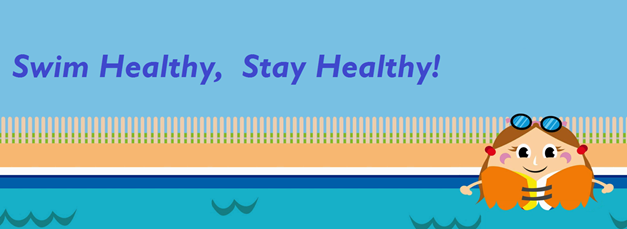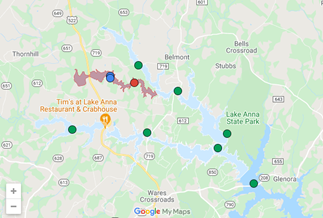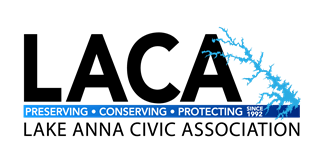By Harry Looney – July 2021
Did you know that the Virginia Department of Health (VDH) sponsors a Swim Healthy, Stay Healthy campaign every recreational season? As part of this program, VDH provides web-based resources covering a wide range of summer recreational activities. You can find these resources here: https://www.vdh.virginia.gov/blog/2018/06/01/swim-healthy-stay-healthy/. These web pages are loaded with information about beach monitoring conducted by state agencies, safe swimming, recreational water illnesses and harmful algae blooms (HABs). 
There are also many fact sheets on health-related issues and diseases. The VDH fact sheet on HABs is provided at the end of this newsletter for informational purposes. Please use this web link to get to the VDH fact sheet listing: https://www.vdh.virginia.gov/epidemiology/epidemiology-fact-sheets/.
HABs are of primary interest to LACA and many Lake Anna residents because it impacts them directly. VDH issued a swim advisory on June 30th for the entire upper Pamunkey Creek area due to the highest cyanobacteria cell counts LACA has seen since 2018.  The VDH web page for reporting a HAB is something you should keep handy if you live in an area that is prone to algae issues. The VDH web page for reporting a HAB is at this link: https://www.vdh.virginia.gov/waterborne-hazards-control/harmful-algal-bloom-online-report-form/.
The VDH web page for reporting a HAB is something you should keep handy if you live in an area that is prone to algae issues. The VDH web page for reporting a HAB is at this link: https://www.vdh.virginia.gov/waterborne-hazards-control/harmful-algal-bloom-online-report-form/.
VDH also maintains an online algal bloom surveillance map for the entire state. The VDH webpage is at this link: https://www.vdh.virginia.gov/waterborne-hazards-control/algal-bloom-surveillance-map/.
LACA is closely monitoring conditions in the upper Pamunkey Creek area and we are dedicating many resources to the entire upper lake area north of the 208 bridge but we need your help in this monitoring campaign. If you see an algae bloom, please notify the LACA Water Quality team by e-mailing Harry Looney at harry.looney@lakeannavirginia.org. Please provide your address, date, and time you saw the bloom, and let me know if it is okay to come on your property to gather water samples. A picture of the bloom is always helpful.
In addition to notifying LACA, we ask that you also submit a report to VDH using the web link provided above. The VDH form asks for information about where the algae is located and it really helps if you can provide the latitude and longitude of the location and a photo of the scum or algae bloom. Provide a perspective image so VDH has a good feel for the extent of the scum on the surface. A good example image that will help both VDH and LACA in our assessments is this image from a bloom on Pamunkey Creek. .jpg) You can obtain the latitude and longitude of the location using Google maps on your PC or laptop or LACA can provide the latitude and longitude if you let us know that you need our help doing that. We will get the coordinates based on your street address and a description of where you saw the scum on the surface.
You can obtain the latitude and longitude of the location using Google maps on your PC or laptop or LACA can provide the latitude and longitude if you let us know that you need our help doing that. We will get the coordinates based on your street address and a description of where you saw the scum on the surface.
Harmful Algal Blooms (HABs) Fact Sheet October 2018
What are harmful algal blooms?
Harmful algal blooms (HABs) are caused by cyanobacteria (also known as blue-green algae) which may or may not produce toxins. Cyanobacteria are common single-celled organisms that naturally exist in fresh waters, such as lakes and ponds, or slightly saline waters such as tidal rivers and estuaries (brackish water). The cyanobacteria utilize sunlight and nutrients from the water to grow and multiply. When there are too many nutrients in the water, the bacteria can grow rapidly or “bloom”. Blooms may turn the water a green, red, or brownish color. Blooms may also form a visible scum on the water surface, similar to the look of spilled paint. Blooms are more likely to occur in hot summer months.
What effects do harmful algal blooms have on humans?
Most cyanobacteria species are not able to produce toxin. Some species can produce one or more types of toxins such as neurotoxins (nerve toxins) or hepatotoxins (liver toxins) during blooms which may be harmful to humans or aquatic life. People may become exposed to cyanobacteria toxins in three ways: swallowing bloom water, direct skin contact, and breathing aerosolized toxins that are in the air.
What are the symptoms of harmful algal bloom exposures?
If water containing cyanobacteria toxin is swallowed, common gastrointestinal symptoms such as stomach pain, nausea, vomiting, and diarrhea may occur. If there is direct contact with cyanobacteria toxin, skin and eye irritation may result, along with tingling or numbness of the lips, fingers and toes, and dizziness. Respiratory irritation may include coughing or wheezing. Long-term exposure to cyanobacteria toxins may result in liver damage or other chronic health effects.
How soon after exposure do symptoms appear?
Symptoms of a neurotoxin HAB exposure may appear within 15-20 minutes while symptoms of a hepatotoxin HAB exposure may take hours or several days to appear. Telling your health care practitioner about contact with water may help him/her treat the illness properly.
What effects do harmful algal blooms have on animals and fish?
Mammals and birds exposed to cyanobacteria toxins may become ill or die. As other bacteria in the water break-down dead cyanobacteria, the dissolved oxygen in the water may become depleted, which may cause a fish kill. Cyanobacteria bloom toxins at high concentrations can be directly harmful to fish and may cause fish kills as well. Dense bacterial blooms in the water column will block out sunlight necessary to other organisms to survive. Wildlife, pets, and livestock are also prone to exposure by wading and drinking bloom water. A small amount of toxin can cause illness to small animals if ingested.
Is it safe to eat seafood from waters with cyanobacteria blooms?
Internal organs (innards) of fish and crabs caught in bloom waters may be contaminated and, therefore, should not be consumed. It is safe to consume fish filets that appear healthy when caught in bloom waters, providing you carefully clean the fish, discarding all guts and the carcass, thoroughly cook the fish fillet, and wash hands and surfaces with fresh, soapy water afterward. In waters with persistent, reoccurring blooms where toxin levels are high, consumption may not be advised.
How do I protect myself from the effects of harmful algal blooms?
- Observe signage indicating a harmful algal bloom is present and avoid contact with the water when instructed.
- Do not swim, wade, or waterski in water that has unusual color or where a cyanobacteria bloom has been identified.
- If direct contact with skin occurs with water containing cyanobacteria, wash off with fresh water. In some cases, skin irritation will appear after prolonged exposure. If symptoms persist, consult your health care provider or your local health department.
- Never drink untreated water. Boiling water taken from a waterbody with a cyanobacteria bloom will not destroy toxins.
- Do not let children, pets, or livestock wade, swim, or drink affected waters. If exposed, wash skin and fur thoroughly with fresh water.
- People who are prone to respiratory allergies or asthma should avoid areas with cyanobacteria blooms.
- Do not eat internal organs or use the carcass for stock of fish caught in HAB waters. If you have cleaned fish fillets caught from affected waters, thoroughly wash any of your skin that has come into contact with the fish, in addition to surfaces during cleaning and preparation. Use rubber gloves if contact with affected waters must be made.
What is Virginia doing about harmful algal blooms?
Several state agencies and municipal governments work together to regularly monitor the water and shellfish growing areas for the presence of cyanobacteria and their toxins, and to conduct surveillance for human health effects. This group is known as the Virginia Harmful Algal Bloom Task Force. The public will be notified if a cyanobacteria bloom that could affect human health is identified. The Algal Bloom map is regularly updated to reflect the status of waterways experiencing a bloom.
How does someone report an algal bloom?
If you are concerned that you have been exposed to a harmful algal bloom, please see your health care provider or call your local health department. Telling your doctor about contact with water may help him/her treat the illness properly. You may also report the exposure on the Harmful Algal Bloom Hotline (888-238-6154). Report algal blooms and fish kills online at http://www.swimhealthyva.com/.
How can I learn more about harmful algal blooms?
Harry Looney, LACA Water Quality Project Officer
harry.looney@lakeannavirginia.org

